8 /10 1 Votes
Release date(s) August 1986 Initial release date 1986 | 4/5 A Game Composer(s) Tadashi Kimijima Cabinet Upright | |||||||||||||||||||||||||||||||||
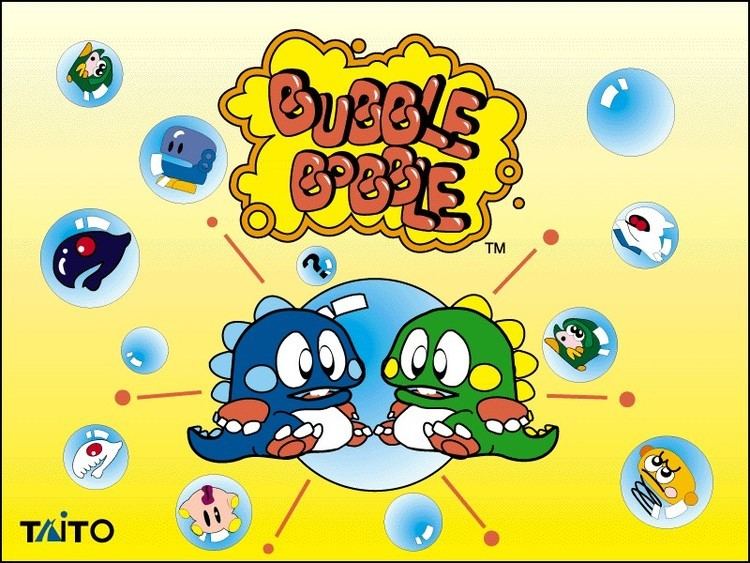 | ||||||||||||||||||||||||||||||||||
Series Bubble Bobble, Arcade Archives Similar Bubble Bobble games, Taito games, Puzzle video games | ||||||||||||||||||||||||||||||||||
Super bubble bobble 1986 taito mame retro arcade games
Bubble Bobble (バブルボブル, Baburu Boburu) is an arcade comical action platformer video game by Taito, first released in 1986 and later ported to numerous home computers and game consoles. The game, starring the twin Bubble Dragons Bub and Bob, tasks players with travelling through one hundred stages, blowing and bursting bubbles, jumping on and off blown bubbles to navigate level obstacles, dodging and eliminating enemies, and collecting a variety of items including some that carry 'power ups' and significant bonuses. For example, some wrapped candies allow Bub and Bob to move faster, blow bubbles faster, and blow bubbles at greater distances. Other items, such as umbrellas, allow to skip numerous levels, moving closer to the final level. The game became popular and led to a long series of sequels and spin-offs. The main goal of the game is to rescue Bub and Bob's girlfriends from the Cave of Monsters. It is an early example of an action game with multiple endings, which depend on the player's performance and discovery of secrets.
Contents
- Super bubble bobble 1986 taito mame retro arcade games
- Arcade longplay 350 bubble bobble
- Gameplay
- Development
- Clones and remakes
- Reception
- Sequels
- Other media
- References
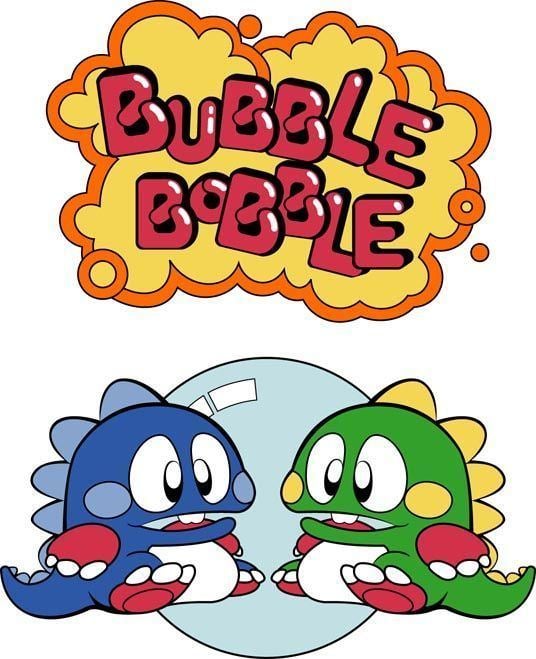
Arcade longplay 350 bubble bobble
Gameplay
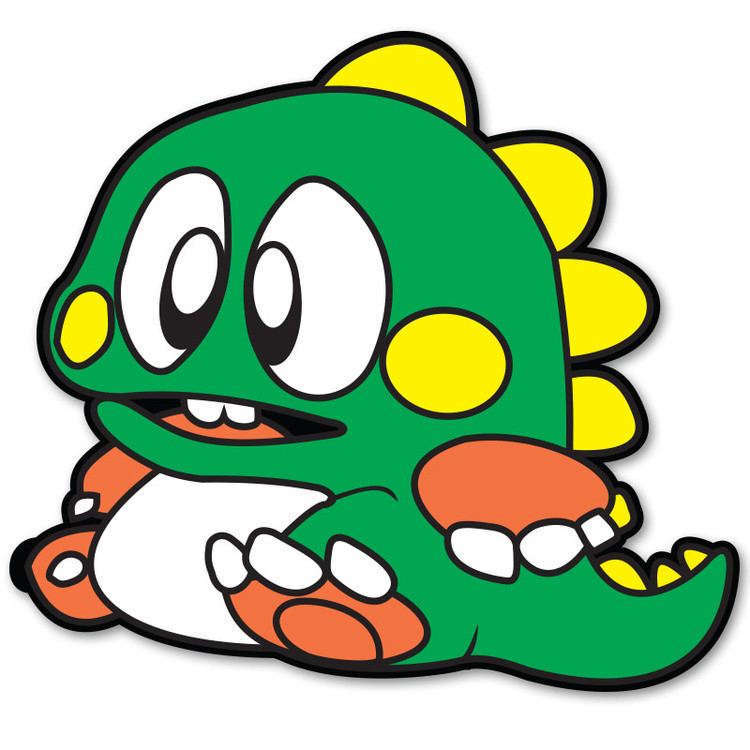
In the game's plot, "Baron Von Blubba" has kidnapped the brothers Bubby and Bobby's girlfriends and turned the brothers into Bubble Dragons, Bub and Bob. Bub and Bob have to finish 100 levels in the Cave of Monsters in order to rescue them.
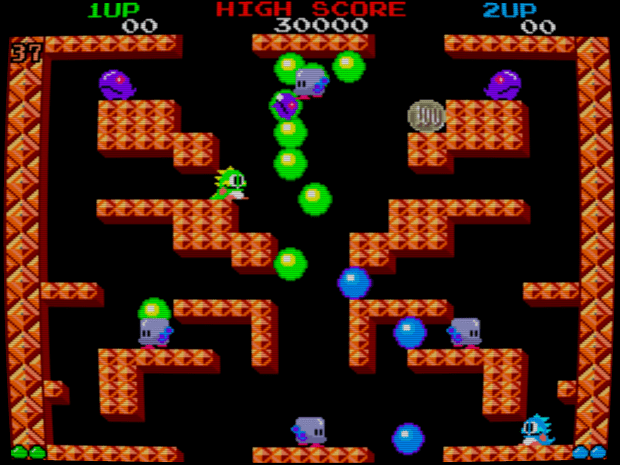
In the game, each player controls one of the two dragons. Players can move along platforms, fall to lower ones, and jump to higher ones and over gaps. Each level is limited to a single screen, with no scrolling; however, if a screen has gaps in its bottom edge, players can fall through these and reappear at the top. Each level has a certain number of enemies that must be defeated in order to advance. The players must blow bubbles to trap the enemies, then burst these bubbles by colliding with them. Each enemy defeated in this manner turns into a food item that can be picked up for extra points. Defeating multiple enemies at once awards higher scores and causes more valuable food items to appear. All bubbles will float for a certain length of time before bursting on their own; players can jump on these and ride them to otherwise inaccessible areas. Magic items appear from time to time and grant special abilities and advantages when picked up. Special bubbles occasionally appear that can be burst to attack enemies with fire, water, or lightning. Furthermore, if a player collects letter bubbles to form the word EXTEND, he/she earns a bonus life and both players immediately advance to the next level.

A player loses one life upon touching any free enemies or their projectiles (rocks, fireballs, lasers, bottles). Enemies turn "angry"—turning pink in color and moving faster—if they escape from a bubble after being left too long or the players spend a certain amount of time on the current level. They return to normal if either player loses a life. After a further time limit expires, an additional invincible enemy appears for each player, actively chasing them using only vertical and horizontal movements. These disappear once the level is cleared, or when a player loses a life. When there is only one enemy left, it immediately becomes angry and remains in this state until defeated.

In the 100th and final level, players face a boss. This game was one of the first to feature multiple endings. Completing Level 100 in single-player mode reveals a message stating that the game has not truly ended and a hint to the player: "Come here with your friend." If two players complete the game, they see a "Happy End," in which the brothers are transformed to their human selves and reunited with their girlfriends. This ending also includes a code that, when deciphered, allows the game to be played in the faster and more difficult "Super" mode. If this mode is completed with two players, a second "Happy End" is displayed in which Super Drunk is revealed to be the brothers' parents under the control of some outside influence. The brothers return to normal and are reunited with their parents and girlfriends.
Development
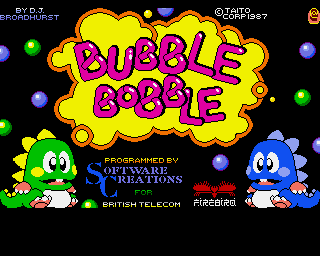
The popularity of Bubble Bobble led Taito (or its licensees) to port the game to many home computers and video game consoles. Ports of the game were released for the Commodore 64, ZX Spectrum, Amiga, Atari ST, MSX2, Amstrad CPC, X68000, PC (DOS, 1989 and 1996), Apple II, FM Towns Marty, Master System, Game Boy, Game Boy Color, PlayStation, Sega Saturn, Nintendo Entertainment System, Famicom Disk System, Game Gear, mobile phone (Sprint PCS) and UltraCade's Taito Arcade Classics.
Of the original 8 and 16 bit ports, the MSX2, NES, Game Boy and Master System ones were made by Taito itself (though the Master System version was distributed by Sega instead of Taito). The Game Gear port (which emulates the Master System version of Bubble Bobble) was done by South Korean developer Open Corporation. The Commodore 64, Spectrum and Amiga versions were developed by Software Creations and published in the UK by Firebird Software. Most of the other computer ports were made by US-based Novalogic with the exception of the X68000 game in Japan that was done by Dempa Shinbunsha.
Commodore 64 coder Steve Ruddy recalled in Retro Gamer:
It wasn't daunting originally, as it looked like a fairly straightforward platform and sprite game. However, once you start playing you noticed how the bubbles followed air flow patterns and how they all gathered in fixed places - lots of sprites on the same line meant a sprite multiplexer wasn't suitable. Fortunately, having worked on the BBC Micro and Mystery of the Nile, I wasn't averse to using software sprites. ... We didn't understand all of the secrets so we just implemented the game to mimic what we did notice. So how the pick-ups appear isn't the same as the arcade on the C64, but it should be very similar to how the pickups appear after the machine is powered up.
The Master System/Game Gear version is noted for having two hundred levels (in effect the normal and super modes consecutively) and is considered one of the best conversions available. This version was originally released as Final Bubble Bobble in 1988 for the Master System in Japan. When it arrived in Europe three years later, the title was shortened to Bubble Bobble. The game was never released for the Master System in North America (the Game Gear being instead the platform in that region for this particular version of Bubble Bobble).
The X68000 version of Bubble Bobble includes a secret "Sybubblun" mode, which contains 20 very difficult levels with the characters changed to those from Syvalion, another game designed by Fukio Mitsuji.
In 1996, Taito announced that they lost the original source code. As Probe Entertainment was in charge of the home conversions, Taito sent them a Bubble Bobble arcade PCB so they could play the original game and reproduce its mechanics. This led to the release of Bubble Bobble also featuring Rainbow Islands for Saturn, PlayStation and PC (DOS) in 1996.
In the Game Boy and Game Boy Color versions, since the Game Boy is in its nature a single player device, the storyline involves Bub looking for "Moon Water" to cure his brother, they are known as Bubble Bobble, and Classic Bubble Bobble respectively.
In October 2005, a version was released for the Xbox, PlayStation 2, and PC as part of the Taito Legends compilation of classic arcade games.
At the end of 2006, a new port for mobile phones in Europe and Japan was released.
On December 31, 2007, the NES version of Bubble Bobble was released on Nintendo's Virtual Console service for the Wii. It costs 500 Wii Points, the equivalent of US$5.
The Famicom version of Bubble Bobble was also released for the Nintendo eShop on October 16, 2013 for the Nintendo 3DS and on January 29, 2014 for the Wii U.
The game's music was written by Japanese team Zuntata. Ports for home computer versions were made by Peter Clarke (Commodore 64), David Whittaker (Amiga) and Tim Follin (Atari ST, ZX Spectrum).
On November 11, 2016, the game (alongside 29 other games) was included in the NES Classic Edition (known as the Nintendo Classic Mini in Europe).
Clones and remakes
The arcade version of Bubble Bobble was widely bootlegged in its day, but due to a security chip installed by Taito (known as the PS4, based on a Motorola 6800) none of the bootlegs played exactly like the original. Through a technique called "decapping", the MAMEDEV team has been able to reverse engineer the workings of the chip and emulate it perfectly. Following that, project Bubble Bobble REDUX has been able to implement an exact version of Bubble Bobble on bootleg boards.
A version also exists for the BBC Micro in the public domain though never officially released. According to one of the creators it was coded by them independently in 1988 as a clone of the C64 version, but when they approached publishers it was deemed that it would not be financially viable to release a licensed product for the BBC Micro at that time.
In 2002 a homebrew version for the Texas Instruments TI-8x series of calculators was released.
During Christmas of 2011, a new version for the Amstrad CPC, entitled Bubble Bobble 4 CPC or BB4CPC was released for free by programmer CNGSoft, as an update to the original/official CPC version.
In 2012 a pair of "hackers" released the Bubble Bobble: Lost Cave project where they have created a new version of Bubble Bobble with 100 new levels that runs on the original arcade hardware. The levels are not created from scratch though, they have been selected as the cream of the crop from the various official ports of the game, since Taito granted almost every Bubble Bobble version some kind of unique content.
Reception
Mean Machines gave the Game Boy port of the game a score of 91%, noting that while some changes had been made, the game played identical to the original arcade port and "provides much addiction and challenge". The four reviewers of Electronic Gaming Monthly stated that the Game Gear version is a faithful conversion of the original which works well in portable form. They particularly praised the simplicity of the gameplay concept and the graphics, and the two-player link option.
The Spectrum version was voted number 58 in the Your Sinclair Readers' Top 100 Games of All Time. GamesRadar ranked it the 24th best NES game ever made. The staff praised its advancements over other platform games of its time and its use of multiple endings.
The creator of Bubble Bobble Fukio Mitsuji (MTJ) went on to create other classics such as Rainbow Islands, Syvalion & Volfied. He died on December 11, 2008.
Sequels
Bubble Bobble has many sequels, including:
Other media
The Bubble Bobble characters have made cameo appearances in the manga Gamest Nª49: Gasmest Island Mokushiroku on October 1992 created by Shinseisha. Bub, from Bubble Bobble and Chack, from Chack'n'Pop, appeared in the manga Cha Kurun Desu (ちゃくるんです) on May 2009. Bubble Bobble was featured in Episode 4, Season 3 of Black Mirror, "San Junipero" as a video game played by Yorkie in 1986 at the Tucker club.
